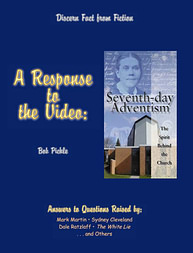|
A Response to the Video:
Seventh-day Adventism, the Spirit Behind the Church
by Bob Pickle
Answers to Questions Raised by:
Mark Martin, Sydney Cleveland
Dale Ratzlaff, The White Lie
. . . and Others
Discern Fact from Fiction
The Millerite Movement
< Prev T. of C. ... 4 5-6 7 8 9 10-11 12-13 14-15 16 17-18 19-20 ... Next >
| #10 & #11: "Ellen Harmon was a willing participant, though when Christ did not
return when Miller predicted, she dissolved into tears and prayers and remained, as she said,
in this hopeless condition for
months."—David Snyder. [p. 21] |
#10: She said this.
There is no such statement anywhere in her writings.
The documentation package lists this as "Point 6," which provides as
proof of the charge page 293 of Life Sketches of James White
and Ellen G. White, 1880 edition. On this page we read, "My wife has for many
years been subject to occasional, and sometimes protracted,
seasons of the most hopeless despair." The immediate context clearly shows that this was
written by Stephen Pierce about his wife, Almira. It
isn't about Mrs. White at all! And the very next paragraph says that this depression started in
May 1852, over seven years after October 22 (p.
294)!
"Point 6" also quotes from Spectrum, a theologically liberal journal
that, unlike Mrs. White, does not advocate the concept of the infallibility
of God's Word (cf. Selected Messages, bk. 1, p. 416). This quotation
speculates that when Mrs. White later wrote about others going insane
because of the teachings of fanatics, she was in fact writing about her own mental state. By
no stretch of the imagination can this be used as proof
that she ever said she was "in this hopeless condition for months."
#11: She felt that way. It simply isn't true. Life
Sketches of Ellen G. White clearly says: "We were disappointed but not
disheartened."—p. 61. If she was not disheartened, it is quite clear that she never "dissolved
into tears and prayers" for months.
Like most young people, she was depressed at times. For instance, she felt in despair
for a period of months around 1840. This was just prior
to her conversion when she was but twelve years old (Selected Messages,
bk. 3, pp. 324, 325). Many feel this way as they realize the depth
of their sin and their need of a Savior.
In 1842 she was convicted that the Lord wanted her to pray publicly, but she didn't
want to and stopped praying altogether. This resulted
in a state of melancholy and despair that lasted three weeks or a little longer, until she
followed through with what she believed was her duty
(Spiritual Gifts, vol. 2, pp. 15-20).
Her second vision, soon after the first one of December 1844, instructed her to share
what God had revealed to her. This troubled her. Being
so young and in frail health, she shrank from the duty of traveling to share with others,
dreading the scoffs, sneers, and opposition she would
surely meet. She wrote:
I really coveted death as a release from the responsibilities that were crowding upon
me. At length the sweet peace I had so long enjoyed left
me, and my soul was plunged in despair.—Life Sketches, 1880 ed., p. 195;
cf. Testimonies for the Church, vol. 1, p. 63.
The words, "sweet peace I had so long enjoyed," indicate that she had no episodes of
despair between the previous incident in 1842 and her
second vision a few months after October 22, 1844. So she was not "in a hopeless condition"
for months after October 22, and had no depression
after Christ did not return when expected.

|

|
Like this book?
Save your printer and your ink!
Buy the entire 160-page book for
just
$9.95 + S/H.
Automatic discounts start
at 5 copies.
|
|
|
< Prev T. of C. ... 4 5-6 7 8 9 10-11 12-13 14-15 16 17-18 19-20 ... Next >
|



